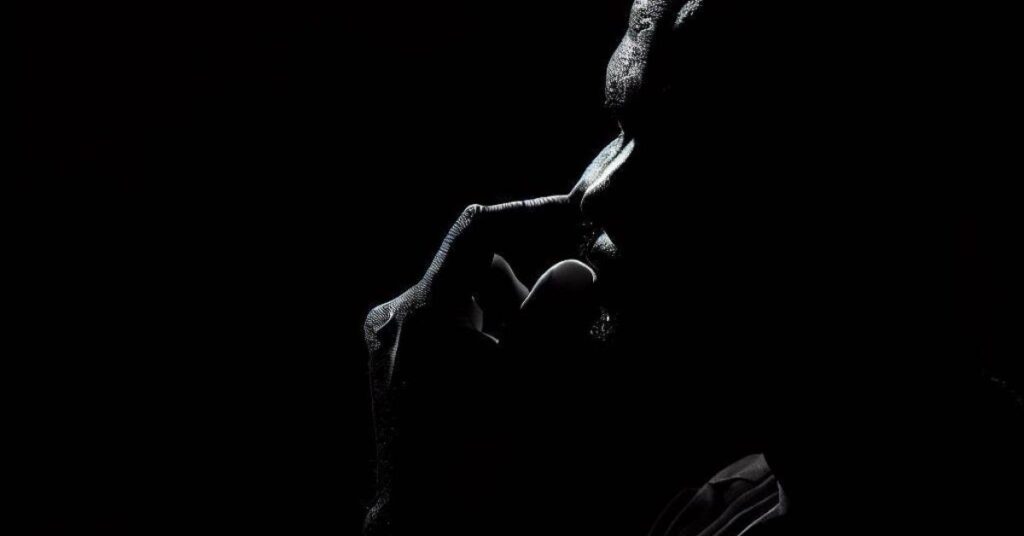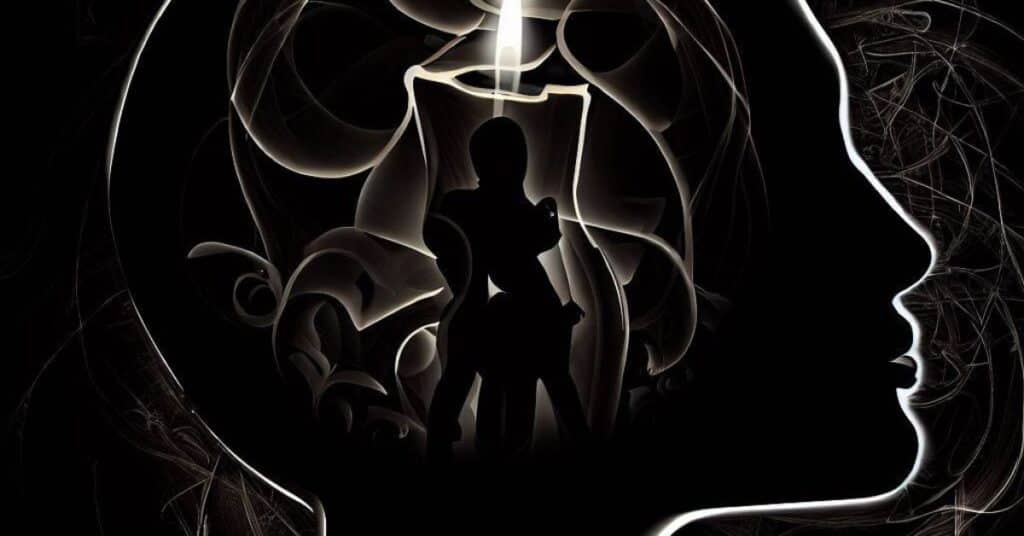Are you ready to embark on a transformative journey into the mysterious realm of your psyche? Welcome, brave explorer, to “How to Integrate Your Shadow Self: The Complete Guide.”
As you venture into the depths of your unconscious mind, you’ll unlock the hidden treasures of your true self, transcending the boundaries of your ego and embracing a more authentic, vibrant existence. The path may be fraught with challenges, but the rewards are immense—unleashing your creativity, gaining powerful insights, and deepening your emotional complexity.
So, grab your metaphorical torch, and let’s delve into the darkness together, asking ourselves: Are you prepared to face the shadow lurking within you?
- What does it mean to integrate your shadow?
- How do you integrate the shadow?
- What is the shadow in Jungian psychology?
- Can you meet your shadow self?
- What triggers your shadow self?
- Shadow self examples
- How do I accept my dark side?
- Confronting fear and resistance
- Tips for overcoming resistance
- Recognizing Patterns and Themes in Your Shadow Self
- Benefits of Integrating our shadow
- Printable Shadow Work Journal
- Printable Shadow Work Prompts
- Final Words
What does it mean to integrate your shadow?
Integrating your shadow is like inviting the mysterious stranger within you to a candlelit dinner, where you both share stories and secrets under the moon’s gaze. In the realm of psychology, the shadow represents the hidden, repressed, or less desirable aspects of ourselves that we often keep in the shadows.
Integrating your shadow means embracing this enigmatic entity, acknowledging its presence, and letting it dance with your conscious self. It’s an act of self-discovery, where you traverse your own labyrinth of emotions, desires, and fears to bring balance and wholeness to your being.
Imagine yourself as a masterful painter, with your shadow as the dark, rich colors on your palette. When you integrate your shadow, you blend these hues into your masterpiece, adding depth, contrast, and intrigue to your life’s canvas.
How do you integrate the shadow?
To integrate your shadow, you must first embark on a quest to discover its secret dwelling place. This requires a courageous heart and an open mind, for the shadow often hides in the corners of our subconscious. Like a skilled treasure hunter, you must explore the caves of your inner world, armed with the lantern of self-awareness.
Once you’ve found your shadow, invite it to a banquet of understanding and acceptance. Lay out a feast of self-love and empathy, garnished with curiosity and non-judgment. As you break bread with your shadow, listen to its stories and learn from its wisdom. Remember, your shadow is a part of you – a reflection of your light and a key to unlocking your full potential.
As you become more familiar with your shadow, it’s time to integrate it into your daily life. This is like learning to dance with both the sun and the moon, allowing their energies to harmonize within you. Embrace the duality of your nature and let your shadow teach you the art of balance. For it is through this delicate dance that we find true inner peace and wholeness.
Finally, to integrate your shadow, you must allow it to express itself creatively. This is like painting with a palette of both light and dark hues, creating a work of art that is both breathtaking and profound. Whether it’s through writing, painting, music, or any other form of self-expression, let your shadow’s voice be heard and celebrated.
What is the shadow in Jungian psychology?
The shadow, a concept birthed by the legendary Carl Jung, is the enigmatic inhabitant of our subconscious realm. It roams unbridled, an ethereal amalgamation of the repressed, the forgotten, and the unacknowledged – aspects of ourselves that we’ve banished into oblivion.
In Jungian psychology, the shadow is the unlit counterpart of our conscious self, a dark mirror reflecting our hidden desires, fears, and insecurities. It is a wraithlike presence, woven from the threads of our untamed emotions, the ones we have deemed too wild, too dangerous, or too shameful to be set free.
The shadow is not an inherently malevolent entity. Rather, it is a misunderstood beast, yearning for recognition and integration. Cloaked in obscurity, it is the treasure trove of untapped potential, a wellspring of creativity waiting to be unearthed. The shadow possesses an enigmatic wisdom, enlightening us about our deepest selves, urging us to embrace our concealed imperfections and harness their power.
In the mystical landscape of the psyche, the shadow is the guardian of the soul’s hidden gems. It is the cryptic navigator, guiding us through the labyrinth of self-discovery. As we wander along the winding path, we must seek to unveil the shadow, to understand its enigmatic language, and to dance with this dark, elusive companion. Only then can we truly delve into the vast expanse of our inner universe and unearth the secrets of our own identity.
Can you meet your shadow self?
In the labyrinthine depths of the human psyche, there exists a realm where shadows dance to the rhythm of our hidden thoughts. It is a place often feared, but seldom explored, for it is home to our shadow self. Can you meet this enigmatic being, the one who holds the mirror to your soul, reflecting your untamed desires, unspoken fears, and long-forgotten memories? The answer, dear traveler, is a resounding yes.
Venture forth into the twilight of your consciousness, armed with courage and curiosity, and you shall find the gateway to your shadow self. This meeting, however, is no ordinary encounter. It is a delicate dance of discovery, a tango of truth and vulnerability, where you must surrender to the whispers of your innermost secrets. Be willing to embrace the darkness, for it is only in facing your shadow that you can truly illuminate the entirety of your being.
As you waltz through the forgotten chambers of your mind, you may stumble upon buried memories, face the phantoms of past traumas, and confront the demons that have long haunted your dreams. Fear not, for this is the path to self-discovery and the key to unlocking the hidden treasures within your soul. By acknowledging and integrating your shadow self, you shall emerge from the dance as a more complete, genuine, and authentic being, ready to shine your light upon the world.
What triggers your shadow self?
As sunlight wanes and darkness creeps in, the stage is set for the enigmatic dance of our shadow self. This hidden aspect of our identity, often masked behind a veil of light, holds the key to our innermost desires, fears, and emotions. To truly understand what triggers our shadow self, we must first embark on a journey of self-discovery, delving deep into the recesses of our psyche.
The Roots of the Shadow
Our shadow self is born from the seeds of our upbringing, societal expectations, and personal experiences. As we navigate through life, we are taught to embrace the light, often suppressing the darkness that lies beneath. However, it is in this darkness that the triggers of our shadow self reside, waiting to be unraveled.
The Unruly Emotions
One of the primary triggers for our shadow self is our emotional palette, particularly the darker shades. As humans, we are prone to experiencing a wide range of emotions. Yet, when faced with anger, sadness, jealousy, or frustration, we are often taught to push these feelings aside. It is in these moments of emotional vulnerability that our shadow self emerges, whispering its desires and urging us to confront our inner turmoil.
The Unmet Needs
Another trigger for our shadow self is the unfulfilled yearnings that lurk within our hearts. These unmet needs, such as the desire for love, acceptance, or validation, often lay dormant, hidden from our conscious mind. However, as we encounter situations that remind us of these unfulfilled desires, our shadow self surfaces, prompting us to acknowledge the deep-rooted needs that we have long ignored.
The Perceived Flaws
Our shadow self is also triggered by our perception of our own flaws and imperfections. In a world where we are constantly bombarded with images of unattainable beauty and success, we often feel inadequate or unworthy. As these feelings of self-doubt simmer within us, our shadow self emerges, revealing the insecurities and fears that we have buried deep within our souls.
The Path to Integration
To dance with our shadow self is not to fear it, but rather to embrace it as a vital part of our being. By acknowledging the triggers that bring forth our shadow self, we can begin to integrate these aspects into our consciousness, creating a harmonious balance of light and dark.
Shadow self examples
The “shadow self” refers to the unconscious aspects of our personality that we often repress or deny. These aspects can manifest in various ways, depending on the individual. Here are a few examples of shadow self traits or behaviors:
- Passive Aggressiveness: Someone who usually comes across as kind and considerate may have a shadow self that displays passive-aggressive behavior when they feel wronged, rather than addressing the issue directly.
- Jealousy: A person who outwardly celebrates the success of others might have a shadow self that harbors jealousy or envy, making them secretly resentful.
- Perfectionism: A seemingly laid-back individual might have a shadow self that is overly critical and strives for perfection, causing them anxiety and self-doubt.
- Procrastination: An organized and punctual person may have a shadow self that struggles with procrastination, causing them to miss deadlines or delay important tasks.
- Authority Issues: Someone who appears confident and self-assured may have a shadow self that questions authority or rebels against established norms, leading to tension in professional or personal relationships.
- Impulsive Behavior: A typically cautious and responsible person may have a shadow self that craves excitement and thrills, leading to impulsive and potentially harmful decisions.
- Fear of Intimacy: A friendly and outgoing individual might have a shadow self that fears emotional vulnerability and intimacy, causing them to sabotage close relationships or avoid deep connections.
By recognizing and integrating these shadow aspects into our conscious awareness, we can work towards achieving balance, self-acceptance, and personal growth.

How do I accept my dark side?
Step 1: Illuminating the Shadows
The first step to accepting your dark side is to bring it out of the shadows and into the light. This requires honesty and courage. Begin by reflecting on your thoughts, feelings, and actions that you might label as “dark” or “negative.” Do you harbor feelings of jealousy, anger, or resentment? Do you sometimes act out of spite or engage in self-sabotage? Recognizing these aspects of yourself is the first step towards understanding and accepting your dark side.
Step 2: The Art of Self-Compassion
Once you have identified your shadow self, it is essential to approach it with kindness and self-compassion. Remember, we are all human beings, and no one is perfect. It is in our nature to experience a full spectrum of emotions, including those we consider “dark.” Treat yourself with the same empathy and understanding you would offer to a dear friend. Accept that you are not defined by your darkest moments but instead are a complex, multifaceted individual capable of growth and change.
Step 3: Embrace the Lessons
Our dark side offers us valuable lessons and opportunities for growth. When we accept and integrate these aspects of ourselves, we can learn from them and harness their power. For example, anger can provide us with the energy and motivation to make changes, while jealousy can highlight areas in our lives where we need to focus on personal development. Embrace the lessons your dark side has to offer, and use them as stepping stones towards self-improvement and personal growth.
Step 4: Balancing the Scales
True acceptance of your dark side involves recognizing that it is an essential part of who you are. Our light and dark sides exist in harmony, and one cannot exist without the other. Embrace the idea that your dark side is not a flaw to be eradicated but a vital aspect of your being that balances the scales. Allow yourself to experience and express the full range of your emotions, understanding that each plays a role in shaping the person you are today.
Step 5: Celebrating Your Wholeness
Having accepted and embraced your dark side, it’s time to celebrate your newfound wholeness. Honor the journey you have undertaken and the growth that has occurred as a result. Recognize the strength and resilience you have gained by facing your shadow self with courage and compassion. Now, you can move forward in your life with a greater sense of self-awareness and a deeper connection to your authentic self.
Conclusion: A Dance of Self-Acceptance
Accepting your dark side is not a one-time event but an ongoing journey of self-discovery and self-acceptance. As you continue to dance with your shadows, remember that your dark side is not something to be feared or shunned but a vital, enriching part of your being. By embracing and integrating your darkness, you pave the way for a life lived in harmony and wholeness, where every step is a celebration of your true, authentic self.
Confronting fear and resistance
The Fear: A Haunting Melody
The haunting melody of fear is an inevitable part of our encounter with the shadow. It’s only natural to fear what we cannot see or understand. The shadow self, with its suppressed emotions and unresolved conflicts, has long been hidden in the darkest corners of our minds. As we attempt to shed light on these hidden aspects, our fear of the unknown and the potential repercussions of unearthing these emotions can be overwhelming.
But fear not, my brave adventurer, for this fear is merely an illusion, a fog that clouds our vision. By acknowledging its presence and allowing it to exist without judgment, we can gradually dissolve the fog and unveil the mysterious shadow self.
Resistance: The Wall of Denial
As we waltz around the ballroom, we may find ourselves stumbling upon a sturdy wall, one built from resistance and denial. This wall protects us from facing our shadow self, fearing that by doing so, we might expose our vulnerabilities and imperfections. We may rationalize our resistance by telling ourselves that our dark side doesn’t exist or that it is insignificant.
However, dear friend, remember that resistance is futile. It only serves to strengthen the divide between our light and dark sides. To break through this wall, we must first acknowledge that our shadow is an integral part of who we are. Embrace the idea that we are beautifully flawed creatures, and by accepting our imperfections, we can find the strength to dismantle the wall of resistance and denial.
The Journey to Wholeness
As we continue our dance with the shadow, fear and resistance may still linger, but they no longer hold the power to control our steps. By embracing our shadow self with kindness and self-compassion, we can learn valuable lessons and insights that contribute to our growth and self-awareness.
So, take a deep breath, hold your shadow’s hand, and let the dance begin. For it is in this dance that we find harmony and balance, and ultimately, the courage to celebrate our newfound wholeness. And as the music fades, we emerge from the ballroom with a deeper connection to our authentic selves, ready to face the world with confidence and grace.
Tips for overcoming resistance
The resistance we feel towards confronting our shadow self is not an impenetrable fortress, but a riddle waiting to be solved. Here are some gentle, creative steps to help you unravel the mystery and embrace the dance with your shadow.
Set Sail with Journaling: Your Personal Treasure Map
Embark on a voyage into the depths of your subconscious with the powerful tool of journaling. Let the pen be the compass that guides you through the maze of emotions and buried truths. Writing about your thoughts and feelings without judgment will help you navigate the uncharted waters of your mind, revealing the hidden treasures that lie beneath the surface.
One of the most effective ways to uncover patterns and themes in your shadow self is through journaling. By writing down your thoughts, feelings, and experiences, you create a space for introspection and self-analysis. Look for recurring themes in your entries, and don’t be afraid to delve deep into your emotions. Journaling can help you identify previously unrecognized patterns and bring clarity to your understanding of your shadow self.
The Compassionate Listener: A Therapist as Your First Mate
Sometimes, the journey to self-discovery requires a supportive companion – a therapist who can be your first mate in this exploration. They can provide guidance and encouragement as you face the unknown. By opening up to a therapist about your fears and resistance, you create a safe space in which to confront your shadow, allowing for a deeper understanding of your emotions and patterns.
Working with a therapist or counselor can help you better identify patterns and themes within your shadow material. These trained professionals can offer guidance and support as you delve into your hidden depths. They can also provide valuable tools and techniques to help you work through any emotional challenges or resistance that may arise during this process.
The Power of Art: Creative Expression as Your Beacon
Creativity can be a powerful ally in overcoming resistance. Engaging in artistic pursuits such as painting, drawing, or writing poetry can help you express your emotions in a non-threatening way. This creative outlet allows you to externalize your shadow self, making it easier to explore and accept. As you create, let your art be the beacon that illuminates the path to self-discovery.
Creative expression can provide a powerful outlet for exploring your shadow self. By letting your creativity flow, you may discover new insights into the patterns and themes that define your shadow. Artistic expression can help you navigate and process complex emotions, fostering a deeper understanding of yourself.
Mindful Meditation: The Calm Amidst the Storm
The stormy seas of fear and resistance can be navigated with the anchor of mindful meditation. By focusing your attention on your breath and observing your thoughts without judgment, you can cultivate a sense of inner peace and clarity. This mindfulness practice will help you to face your shadow with a calm and open mind, enabling you to embrace the hidden aspects of yourself with compassion and understanding.
The Power of Affirmations: Your Mantra for Bravery
Facing our shadow self can be a daunting task, but with the power of positive affirmations, you can muster the courage to dive into the depths. Repeat empowering mantras such as “I am strong,” “I am worthy of self-discovery,” or “I embrace my whole self.” By reciting these affirmations, you create a shield of bravery and self-love that guards your heart as you venture into the unknown.

Recognizing Patterns and Themes in Your Shadow Self
To begin analyzing your shadow self, start by reflecting on your emotional reactions, behaviors, and thoughts that might stem from this hidden part of you. Look for recurring patterns and themes in your past experiences, relationships, and choices. Some common shadow themes might include:
- Fear of rejection or abandonment
- Struggles with self-worth and self-esteem
- Feelings of unworthiness or inadequacy
- Difficulty trusting others or forming deep connections
- Patterns of self-sabotage or procrastination
Benefits of Integrating our shadow
Increased Creativity
Unblocking suppressed emotions
When we integrate our shadow, we acknowledge and accept the repressed emotions and desires that we have kept hidden. This process of acceptance frees up mental and emotional energy previously spent on suppression, allowing us to channel it into creative pursuits. As a result, we may experience a surge in creativity and find new inspiration in our art, writing, or other forms of self-expression.
Gaining insights from the unconscious
Our unconscious mind is a treasure trove of ideas and insights that often remain untapped. By embracing our shadow self, we can access these hidden gems and use them to fuel our creativity. This includes recognizing patterns and themes in our emotional reactions, behaviors, and thoughts, which can inspire new creative projects or provide fresh perspectives on existing work.
Enhancing emotional depth and complexity
Integrating our shadow self can add emotional depth and complexity to our creative work. By exploring and understanding our darker emotions and desires, we can create more authentic, nuanced portrayals of the human experience. This emotional richness can elevate our creative projects and resonate with others on a deeper level.
Increased Authenticity
Embracing our true selves
Authenticity stems from embracing all aspects of our personality, including our shadow material. When we integrate our shadow, we become more in tune with our genuine thoughts, feelings, and desires. This self-awareness allows us to live more authentically, as we no longer feel the need to hide or suppress parts of ourselves.
Strengthening personal relationships
When we accept and embrace our shadow self, we become more honest and open with ourselves and others. This transparency can lead to stronger, more genuine connections with the people around us. As we share our true selves, we can foster deeper, more meaningful relationships built on trust and understanding.
Boosting self-confidence
Authenticity breeds self-confidence. When we integrate our shadow and embrace our true selves, we develop a stronger sense of self-worth and self-acceptance. This newfound confidence can empower us to take risks, pursue our passions, and make decisions that align with our values and desires.
Final Words
As we conclude our odyssey through the enigmatic world of the shadow self, it’s essential to recognize the immense potential that lies within the integration of our darker aspects. By harnessing the power of art, writing, and self-compassion, we can transform our shadows into sources of strength, creativity, and authenticity.
Embrace the journey of self-discovery, and remember that integrating your shadow self is an ongoing process, one that requires curiosity, courage, and commitment.
So, as you step back into the light, ask yourself: What new depths of your psyche will you explore next on your path to personal growth?

